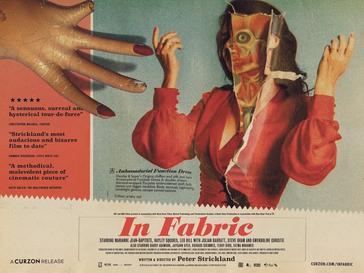Horror sometimes takes a creative turn. In Fabric is an art film as well as a horror offering. The basic premise is that a certain red dress, sold at a bizarre fashion store, causes the death of those who wear it. Sheila, recently divorced and having trouble with her adult, at home son, buys the dress for a date. After leaving her with a rash, the dress leads to an arm laceration, a German Shepherd attack, an attack on her son’s girlfriend, and finally, Sheila’s death in an auto accident. The dress is then picked up by a guy as a stag party prank where the groom has to wear it. His soon-to-be wife finds it and wears it also. The man, Reg, loses his job as a washing machine repairman and has no luck finding another. While Babs, his wife, is shopping at that same strange shop, Reg’s furnace malfunctions, killing him with carbon monoxide. Babs is trapped in the shop as it catches fire and burns down. All those killed by the dress are shown working on new ones at the end of the film.

The movie is also called a dark comedy and there are some funny bits. The sales clerk, Miss Luckmoore, speaks in cryptic, quasi-poetic style, never giving a straight answer to anyone. The shop’s owner does the same. And some of the scenarios are amusing. Although horror, the movie isn’t really scary, but it is stylish. Unlike some horror comedies, the tone isn’t really funny, but more wry. And it’s a bit confusing. The overall story arc is easy enough to follow, but some scenes just confound. I kept waiting for an a-ha moment when everything would fall into place. Of course, ambiguity is a hallmark of many intellectual films.
Something that I’ve been noticing, no matter the era that it’s from, is that films really need to justify that last half-hour, if they’re going for 120 minutes. Maybe it’s just that we’ve become accustomed to the 90-minute feature, but I’ve notice that most two-hour movies (not all) seem to suffer from some pacing issues. Of course, an art-house movie will defy conventions. For example, the point of view is Shelia’s for about the first half of the film, then she’s killed and new characters are introduced. Yes, this shows that the dress goes on killing, but another approach might’ve been to have the protagonist learn about past killings and realize the dress is coming for her. But then, that might’ve been less creative.
